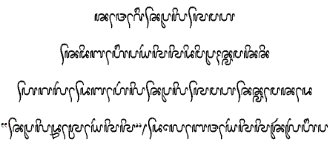Balinese love poem
ᬫᬾᬓ
ᬮᬯᬢ᭄ ᬳᬶᬧᬸᬦ᭄ ᬭᬶᬂ ᬫᬾᬓᬾ
ᬦᬶᬓᬶ ᬯᬦ᭄ᬢᬄ ᬧᬸᬯᬶᬲᬶ ᬢᬶᬢᬶᬬᬂ ᬧᬮᬶᬂ ᬩᬾᬘᬶᬓ᭄
ᬲᬓᬾᬯᬦ᭄ᬢᬾᬦ᭄ ᬮᬯᬢ᭄ ᬳᬶᬧᬸᬦ᭄ ᬳᬶᬮᬂ ᬩᬾᬲ᭄ ᬳᬾᬂᬕᬮ᭄
ᬧᬮᬶᬂ ᬳᬸᬂᬓᬸᬃ ᬢᬶᬢᬶᬬᬂ ᬫᬾᬩᬳᭀᬲ᭄᭞ “ᬢᬶᬢᬶᬬᬂ ᬢ᭄ᬭᬾᬲ᭄ᬦᬾ ᬳᬶᬧᬸᬦ᭄”

Latins letters from aksara script
Meka
Lawat ipun ring meka
Niki wantah puisi titiang paling becik
Sakewanten lawat ipun ilang bes enggal
Paling ungkur titiang mebaos, “titiang tresne ipun”

→ French poem ←
Balinese language
My love poem in its Balinese version (alternatives : Balinese, Badung, Buleleng, Jembrana, Nusa Penida, Tabanan, Klungkung, Lowland Bali, Karangasem, Bali Aga, Bali, Highland Bali, Gianyar), a Malayo-Polynesian language of Indonesia.
Basa bali, a Malay-Sumbawian language, spoken in the islands of Bali and in East Java by 2 million people, is in decline, its number of speakers is decreasing.
The characteristic of the island, its tourism, is very important, since as these tourists do not speak Balinese, it is indeed English which is most often used.
These tourists (nearly 3 million per year) bring their language with them, and we find everywhere in Bali on the signs Chinese, Japanese, Korean, French, Dutch, Russian etc. languages which can be mixed.
Most often, and obviously in the tourism sector, the Balinese will be largely multilingual with at least in addition to their mother tongue, English and Indonesian.
Balinese is written either with Latin letters or with its own syllabic system, the Balinese script (aksara or hanacaraka, anacaraka).
Bali
The island of Bali which is approximately 140km x 80km, is one of the small Sunda Islands. It is located right between the islands of Java and Lombok.
For what we know of the history of Bali, it is that the first Austronesians began to arrive four thousand years ago. The island will be in turn influenced by India, China, and the Javanese under the Islamic pressure.
the reign of King Baturenggong in the 16th century marks the island's golden age while the 17th and 18th centuries, which saw the Balinese populations deported into slavery, was not the brightest.
If the Dutch have been in the region for a long time, it is only at the very beginning of the 20th century, that following massacres, they will completely dominate the island. The Japanese occupation during the war followed, then it will be the independence of all these islands through the creation of the Indonesian state.
Balinese culture has long been influenced: India, China, then in the 15th century by the invasion of the Majapahit kings in East Java, then by Dutch colonization, then very early in the 20th century, by expatriates and tourism.
This culture Bali Aga has therefore evolved and managed to preserve itself. The mix of Hinduism, animism, and ancestor worship found in Bali is unique in Indonesia.
When the Indonesian state was created in 1949, it initially emphasized a national rather than local identity, but if Bali's economic life revolves around its tourism, it owes it of course to its landscapes but also to its culture.
Bali is indeed a tourist island par excellence, since tourists come there from all over the world. In addition to tourism which has developed in the last century, its two other resources are crafts and agriculture.
The magnificent Hindu temples, dances, crafts (wood carving) bring it an important financial windfall, and make it a very rich Indonesian island. Bali is characterized by active volcanism.